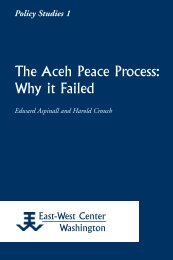Constructing Papuan Nationalism: History, Ethnicity ... - ScholarSpace
Constructing Papuan Nationalism: History, Ethnicity ... - ScholarSpace
Constructing Papuan Nationalism: History, Ethnicity ... - ScholarSpace
- No tags were found...
You also want an ePaper? Increase the reach of your titles
YUMPU automatically turns print PDFs into web optimized ePapers that Google loves.
<strong>Constructing</strong> <strong>Papuan</strong> <strong>Nationalism</strong> 85sometimes, in contrast to the sharp distinctions drawn between <strong>Papuan</strong>sand Indonesians.Indonesia’s victory over the Dutch in 1962 and its subsequent abilityto enforce its authority in Papua together with the many shifts in governmentpolicy have changed the parameters in which <strong>Papuan</strong>s have made achoice between Indonesian and <strong>Papuan</strong> futures. Indonesian rule has meantthat these political choices for elite <strong>Papuan</strong>s have been decisions of farreaching consequences for their own and their family’s security, education,and employment prospects. Few members of the elite made the decisionto go to the bush and join the OPM struggle against Indonesian rule,however much they might have identified with the ideal of independence.It has also been the case that there have always been <strong>Papuan</strong>s who havebeen willing to accept senior positions in the Indonesian administration.Some of them, like Bonay and Wayoi in the 1960s, and many of the seniorgovernment officials in Jayapura today, have been nationalists. In somecases, this has meant that their tenure has been brief, while in others it hasmeant that the office holders have not been trusted by the authorities inJakarta. The seemingly dual and shifting allegiances of the many <strong>Papuan</strong>nationalists who have worked as senior Indonesian officials can perhaps besymbolized by Filip Karma, leader of the 1998 Biak demonstration and asenior civil servant. In late 2000 the author saw him in Jayapura dressedin conventional Indonesian bureaucratic attire, yet with a large <strong>Papuan</strong>flag pinned on his chest. 141 As indicated by this display, the means thatIndonesia used to maintain its authority did much to consolidate pan-<strong>Papuan</strong> identity and <strong>Papuan</strong>s’ commitment to independence. As a result,when the reformasi of the late 1990s again allowed open expression of dissent,<strong>Papuan</strong> nationalism turned out to have developed broader and deeperroots. The success with which the reformasi era nationalists mobilizedsupport throughout Papua is a measure of the growth and spread of<strong>Papuan</strong> identity in the intervening decades. Thus it was that during the“<strong>Papuan</strong> Spring” of 1998–2000, the debate among <strong>Papuan</strong>s was not simplya debate between a <strong>Papuan</strong> future and an Indonesian one. Rather, ithad become a more specific one between forms of greater <strong>Papuan</strong> controlover their own land, that is, between either independence from or greaterautonomy within Indonesia. Since the government’s recent decision todivide Papua into three provinces, the debate appears to have shifted yetagain to a choice between partition and the full implementation of theSpecial Autonomy Law. Yet, despite the current limited space for the
















